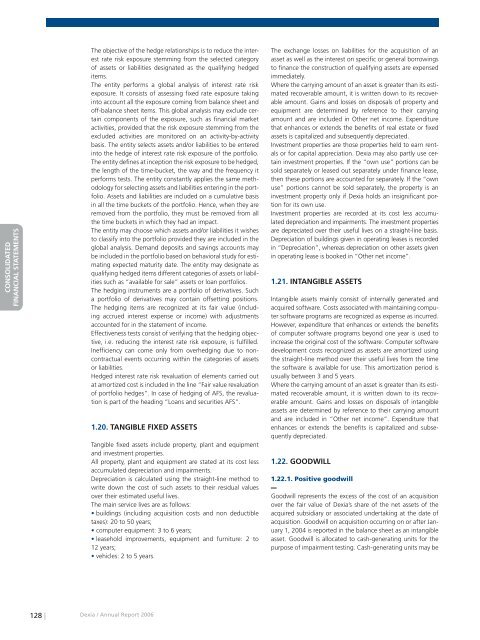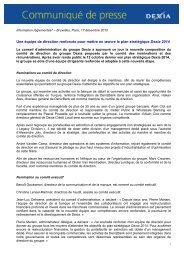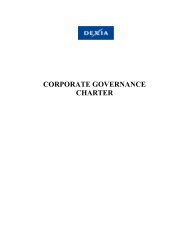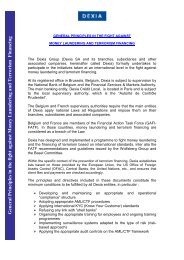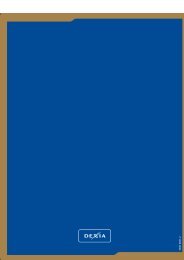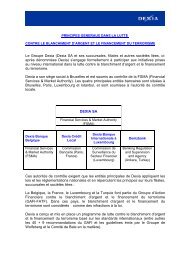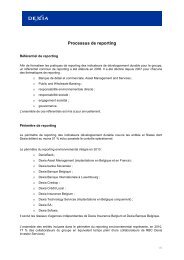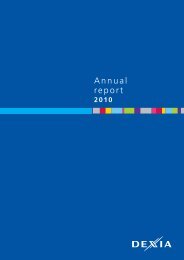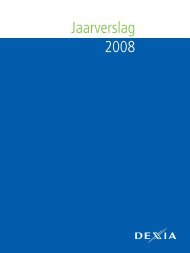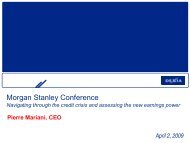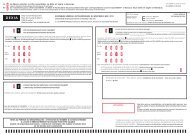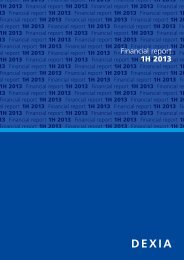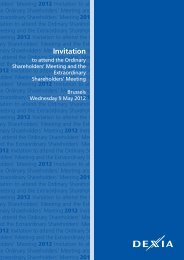Annual report 2006 - Dexia.com
Annual report 2006 - Dexia.com
Annual report 2006 - Dexia.com
Create successful ePaper yourself
Turn your PDF publications into a flip-book with our unique Google optimized e-Paper software.
RAPPORT DE GESTION<br />
CONSOLIDATED<br />
FINANCIAL STATEMENTS<br />
COMPTES SOCIAUX<br />
The objective of the hedge relationships is to reduce the interest<br />
rate risk exposure stemming from the selected category<br />
of assets or liabilities designated as the qualifying hedged<br />
items.<br />
The entity performs a global analysis of interest rate risk<br />
exposure. It consists of assessing fixed rate exposure taking<br />
into account all the exposure <strong>com</strong>ing from balance sheet and<br />
off-balance sheet items. This global analysis may exclude certain<br />
<strong>com</strong>ponents of the exposure, such as financial market<br />
activities, provided that the risk exposure stemming from the<br />
excluded activities are monitored on an activity-by-activity<br />
basis. The entity selects assets and/or liabilities to be entered<br />
into the hedge of interest rate risk exposure of the portfolio.<br />
The entity defines at inception the risk exposure to be hedged,<br />
the length of the time-bucket, the way and the frequency it<br />
performs tests. The entity constantly applies the same methodology<br />
for selecting assets and liabilities entering in the portfolio.<br />
Assets and liabilities are included on a cumulative basis<br />
in all the time buckets of the portfolio. Hence, when they are<br />
removed from the portfolio, they must be removed from all<br />
the time buckets in which they had an impact.<br />
The entity may choose which assets and/or liabilities it wishes<br />
to classify into the portfolio provided they are included in the<br />
global analysis. Demand deposits and savings accounts may<br />
be included in the portfolio based on behavioral study for estimating<br />
expected maturity date. The entity may designate as<br />
qualifying hedged items different categories of assets or liabilities<br />
such as “available for sale” assets or loan portfolios.<br />
The hedging instruments are a portfolio of derivatives. Such<br />
a portfolio of derivatives may contain offsetting positions.<br />
The hedging items are recognized at its fair value (including<br />
accrued interest expense or in<strong>com</strong>e) with adjustments<br />
accounted for in the statement of in<strong>com</strong>e.<br />
Effectiveness tests consist of verifying that the hedging objective,<br />
i.e. reducing the interest rate risk exposure, is fulfilled.<br />
Inefficiency can <strong>com</strong>e only from overhedging due to noncontractual<br />
events occurring within the categories of assets<br />
or liabilities.<br />
Hedged interest rate risk revaluation of elements carried out<br />
at amortized cost is included in the line “Fair value revaluation<br />
of portfolio hedges”. In case of hedging of AFS, the revaluation<br />
is part of the heading “Loans and securities AFS”.<br />
1.20. TANGIBLE FIXED ASSETS<br />
Tangible fixed assets include property, plant and equipment<br />
and investment properties.<br />
All property, plant and equipment are stated at its cost less<br />
accumulated depreciation and impairments.<br />
Depreciation is calculated using the straight-line method to<br />
write down the cost of such assets to their residual values<br />
over their estimated useful lives.<br />
The main service lives are as follows:<br />
• buildings (including acquisition costs and non deductible<br />
taxes): 20 to 50 years;<br />
• <strong>com</strong>puter equipment: 3 to 6 years;<br />
• leasehold improvements, equipment and furniture: 2 to<br />
12 years;<br />
• vehicles: 2 to 5 years.<br />
The exchange losses on liabilities for the acquisition of an<br />
asset as well as the interest on specific or general borrowings<br />
to finance the construction of qualifying assets are expensed<br />
immediately.<br />
Where the carrying amount of an asset is greater than its estimated<br />
recoverable amount, it is written down to its recoverable<br />
amount. Gains and losses on disposals of property and<br />
equipment are determined by reference to their carrying<br />
amount and are included in Other net in<strong>com</strong>e. Expenditure<br />
that enhances or extends the benefits of real estate or fixed<br />
assets is capitalized and subsequently depreciated.<br />
Investment properties are those properties held to earn rentals<br />
or for capital appreciation. <strong>Dexia</strong> may also partly use certain<br />
investment properties. If the “own use” portions can be<br />
sold separately or leased out separately under finance lease,<br />
then these portions are accounted for separately. If the “own<br />
use” portions cannot be sold separately, the property is an<br />
investment property only if <strong>Dexia</strong> holds an insignificant portion<br />
for its own use.<br />
Investment properties are recorded at its cost less accumulated<br />
depreciation and impairments. The investment properties<br />
are depreciated over their useful lives on a straight-line basis.<br />
Depreciation of buildings given in operating leases is recorded<br />
in “Depreciation”, whereas depreciation on other assets given<br />
in operating lease is booked in “Other net in<strong>com</strong>e”.<br />
1.21. INTANGIBLE ASSETS<br />
Intangible assets mainly consist of internally generated and<br />
acquired software. Costs associated with maintaining <strong>com</strong>puter<br />
software programs are recognized as expense as incurred.<br />
However, expenditure that enhances or extends the benefits<br />
of <strong>com</strong>puter software programs beyond one year is used to<br />
increase the original cost of the software. Computer software<br />
development costs recognized as assets are amortized using<br />
the straight-line method over their useful lives from the time<br />
the software is available for use. This amortization period is<br />
usually between 3 and 5 years.<br />
Where the carrying amount of an asset is greater than its estimated<br />
recoverable amount, it is written down to its recoverable<br />
amount. Gains and losses on disposals of intangible<br />
assets are determined by reference to their carrying amount<br />
and are included in “Other net in<strong>com</strong>e”. Expenditure that<br />
enhances or extends the benefits is capitalized and subsequently<br />
depreciated.<br />
1.22. GOODWILL<br />
1.22.1. Positive goodwill<br />
Goodwill represents the excess of the cost of an acquisition<br />
over the fair value of <strong>Dexia</strong>’s share of the net assets of the<br />
acquired subsidiary or associated undertaking at the date of<br />
acquisition. Goodwill on acquisition occurring on or after January<br />
1, 2004 is <strong>report</strong>ed in the balance sheet as an intangible<br />
asset. Goodwill is allocated to cash-generating units for the<br />
purpose of impairment testing. Cash-generating units may be<br />
128 |<br />
<strong>Dexia</strong> / <strong>Annual</strong> Report <strong>2006</strong>


